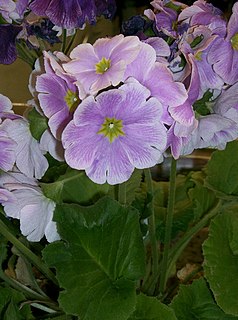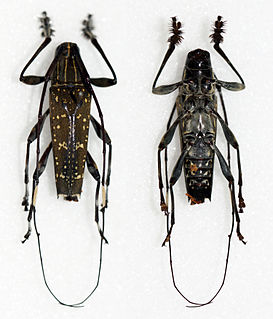Related Research Articles

Coprosma is a genus of flowering plants in the family Rubiaceae. It is found in New Zealand, Hawaiian Islands, Borneo, Java, New Guinea, islands of the Pacific Ocean to Australia and the Juan Fernández Islands.
Puya obconica is a species of plant in the family Bromeliaceae. It is endemic to Ecuador. Its natural habitats are subtropical or tropical moist montane forests and subtropical or tropical high-altitude shrubland. It is threatened by habitat loss.
Canningella is an extinct genus of sponge in the family Anthaspidellidae. There are at least four described species in Canningella.

Primula obconica is a species of flowering plant in the family Primulaceae, native to China. It is a short-lived evergreen perennial growing to 40 cm (16 in) tall by 25 cm (10 in) broad, with rosettes of coarse, heart-shaped leaves, and thick stalks bearing umbels of lavender flowers in late winter and early spring.

Colobotheini is a tribe of longhorn beetles of the subfamily Lamiinae.

Colobothea is a genus of longhorn beetles of the subfamily Lamiinae.
Colobothea decemmaculata is a species of beetle in the family Cerambycidae. It was described by Bates in 1865. It is known from Brazil and French Guiana.
Colobothea pimplaea is a species of beetle in the family Cerambycidae. It was described by Bates in 1865. It is known from Brazil, French Guiana, and Peru.
Colobothea subtessellata is a species of beetle in the family Cerambycidae. It was described by Bates in 1865. It is known from Brazil.
Colobothea discicollis is a species of beetle in the family Cerambycidae. It was described by Gahan in 1889. It is known from Brazil.
Colobothea socia is a species of beetle in the family Cerambycidae. It was described by Gahan in 1889. It is known from Brazil.

Colobothea assimilis is a species of beetle in the family Cerambycidae. It was described by Per Olof Christopher Aurivillius in 1902.
Colobothea andina is a species of beetle in the family Cerambycidae. It was described by Monné in 1993. It is known from Peru.
Colobothea picturata is a species of beetle in the family Cerambycidae. It was described by Monné in 1993. It is known from Venezuela.

Colobothea meleagrina is a species of beetle in the family Cerambycidae. It was described by Wilhelm Ferdinand Erichson in 1847. IT is known from Bolivia, Ecuador and Peru.
Colobothea chemsaki is a species of beetle in the family Cerambycidae. It was described by Giesbert in 1979. It is known from Costa Rica and Mexico.
Colobothea fasciatipennis is a species of beetle in the family Cerambycidae. It was described by Linsley in 1935. It is known from Honduras and Panama.
Holocarpha obconica, commonly known as the San Joaquin tarweed, is a North American plant species in the sunflower family. It is endemic to California, primarily in the Central Valley and adjacent regions.
Eucalyptus obconica is a species of small tree or a mallee the is endemic to the Kimberley region of Western Australia. It has rough fibrous or flaky, wavy bark on the trunk and branches, lance-shaped to curved or oblong adult leaves, flower buds in groups of seven, white flowers and conical fruit.
Monilaria obconica is a species from family Aizoaceae first described by H.D. Ihlenfeldt and S. Jorgensen. Monilaria obconica is part of the genus Monilaria. no subspecies are listed in the Catalogue of Life. This species is endemic to Namaqualand region.
References
- ↑ BioLib.cz - Colobothea obconica. Retrieved on 8 September 2014.